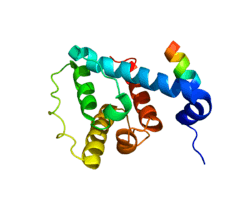PARVA
Alpha-parvin is a protein that in humans is encoded by the PARVA gene.[5][6]
Members of the parvin family, including PARVA, PARVB and PARVG, are actin-binding proteins associated with focal contacts.[supplied by OMIM][6]
References
- 1 2 3 GRCh38: Ensembl release 89: ENSG00000197702 - Ensembl, May 2017
- 1 2 3 GRCm38: Ensembl release 89: ENSMUSG00000030770 - Ensembl, May 2017
- ↑ "Human PubMed Reference:".
- ↑ "Mouse PubMed Reference:".
- ↑ Olski TM, Noegel AA, Korenbaum E (Feb 2001). "Parvin, a 42 kDa focal adhesion protein, related to the alpha-actinin superfamily". J Cell Sci. 114 (Pt 3): 525–38. PMID 11171322.
- 1 2 "Entrez Gene: PARVA parvin, alpha".
Further reading
- Nikolopoulos SN, Turner CE (2001). "Actopaxin, a new focal adhesion protein that binds paxillin LD motifs and actin and regulates cell adhesion". J. Cell Biol. 151 (7): 1435–48. doi:10.1083/jcb.151.7.1435. PMC 2150668. PMID 11134073.
- Tu Y, Huang Y, Zhang Y, et al. (2001). "A new focal adhesion protein that interacts with integrin-linked kinase and regulates cell adhesion and spreading". J. Cell Biol. 153 (3): 585–98. doi:10.1083/jcb.153.3.585. PMC 2190577. PMID 11331308.
- Nikolopoulos SN, Turner CE (2002). "Molecular dissection of actopaxin-integrin-linked kinase-Paxillin interactions and their role in subcellular localization". J. Biol. Chem. 277 (2): 1568–75. doi:10.1074/jbc.M108612200. PMID 11694518.
- Korenbaum E, Olski TM, Noegel AA (2002). "Genomic organization and expression profile of the parvin family of focal adhesion proteins in mice and humans". Gene. 279 (1): 69–79. doi:10.1016/S0378-1119(01)00743-0. PMID 11722847.
- Zhang Y, Chen K, Tu Y, et al. (2003). "Assembly of the PINCH-ILK-CH-ILKBP complex precedes and is essential for localization of each component to cell-matrix adhesion sites". J. Cell Sci. 115 (Pt 24): 4777–86. doi:10.1242/jcs.00166. PMID 12432066.
- Strausberg RL, Feingold EA, Grouse LH, et al. (2003). "Generation and initial analysis of more than 15,000 full-length human and mouse cDNA sequences". Proc. Natl. Acad. Sci. U.S.A. 99 (26): 16899–903. doi:10.1073/pnas.242603899. PMC 139241. PMID 12477932.
- Ota T, Suzuki Y, Nishikawa T, et al. (2004). "Complete sequencing and characterization of 21,243 full-length human cDNAs". Nat. Genet. 36 (1): 40–5. doi:10.1038/ng1285. PMID 14702039.
- Aboulaich N, Vainonen JP, Strålfors P, Vener AV (2005). "Vectorial proteomics reveal targeting, phosphorylation and specific fragmentation of polymerase I and transcript release factor (PTRF) at the surface of caveolae in human adipocytes". Biochem. J. 383 (Pt 2): 237–48. doi:10.1042/BJ20040647. PMC 1134064. PMID 15242332.
- Zhang Y, Chen K, Tu Y, Wu C (2004). "Distinct roles of two structurally closely related focal adhesion proteins, alpha-parvins and beta-parvins, in regulation of cell morphology and survival". J. Biol. Chem. 279 (40): 41695–705. doi:10.1074/jbc.M401563200. PMID 15284246.
- Clarke DM, Brown MC, LaLonde DP, Turner CE (2004). "Phosphorylation of actopaxin regulates cell spreading and migration". J. Cell Biol. 166 (6): 901–12. doi:10.1083/jcb.200404024. PMC 2172128. PMID 15353548.
- Gerhard DS, Wagner L, Feingold EA, et al. (2004). "The status, quality, and expansion of the NIH full-length cDNA project: the Mammalian Gene Collection (MGC)". Genome Res. 14 (10B): 2121–7. doi:10.1101/gr.2596504. PMC 528928. PMID 15489334.
- LaLonde DP, Brown MC, Bouverat BP, Turner CE (2005). "Actopaxin interacts with TESK1 to regulate cell spreading on fibronectin". J. Biol. Chem. 280 (22): 21680–8. doi:10.1074/jbc.M500752200. PMID 15817463.
- Rual JF, Venkatesan K, Hao T, et al. (2005). "Towards a proteome-scale map of the human protein-protein interaction network". Nature. 437 (7062): 1173–8. doi:10.1038/nature04209. PMID 16189514.
- Ewing RM, Chu P, Elisma F, et al. (2007). "Large-scale mapping of human protein-protein interactions by mass spectrometry". Mol. Syst. Biol. 3 (1): 89. doi:10.1038/msb4100134. PMC 1847948. PMID 17353931.
This article is issued from
Wikipedia.
The text is licensed under Creative Commons - Attribution - Sharealike.
Additional terms may apply for the media files.





